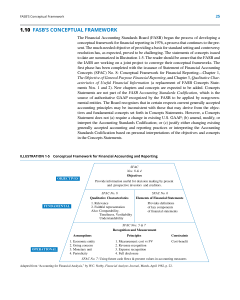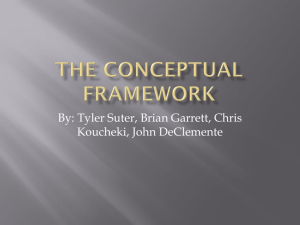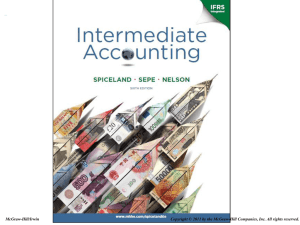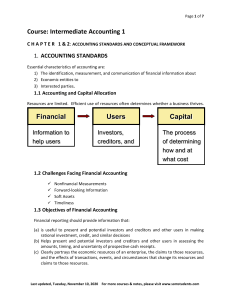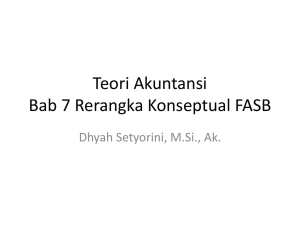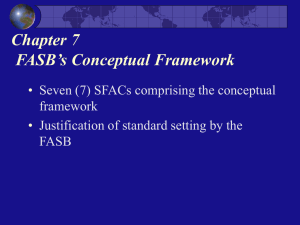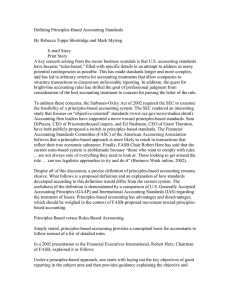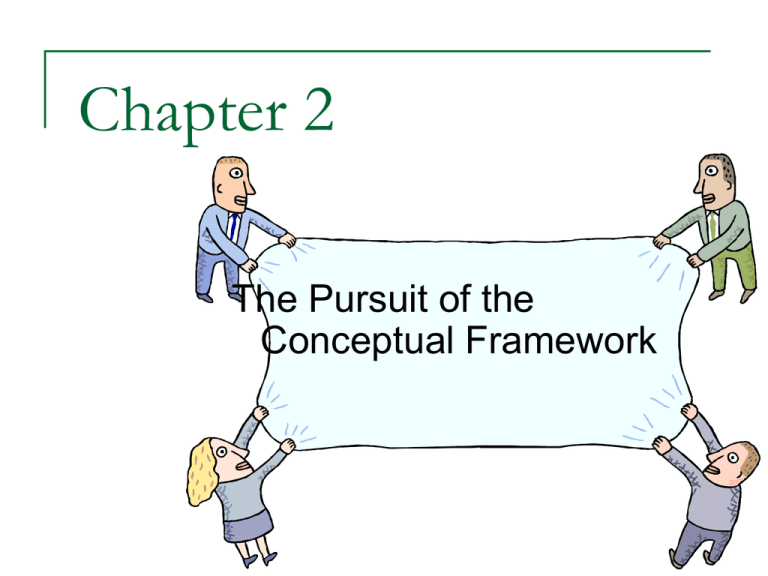
Chapter 2
The Pursuit of the
Conceptual Framework
Introduction
What is the conceptual framework?
The Early Theorists
Paton and Canning
DR Scott and his conceptual framework
Early Authoritative and Semi-authoritative
Organizational Attempts to Develop the Conceptual
Framework of Accounting
A Tentative
Statement of
Accounting
Principles
Affecting
Corporate
Reports
A
Statement
of
Accounting
Principles
APB
Statement
No. 4
An
Introduction
to Corporate
Accounting
Standards
ASOBAT
ARSs
No. 1
and
No. 3
The Trueblood Committee
1.
2.
3.
4.
Committee report specified the following
four information needs of users:
Making decisions concerning the use of limited resources
Effectively directing and controlling organizations
Maintaining and reporting on the custodianship of resources
Facilitating social functions and controls
Objectives of financial reporting
Statement on Accounting Theory and
Theory Acceptance
Rationale for the committee’s approach
The approaches to accounting theory
were condensed into
1.
2.
3.
Classical
Decision Usefulness
Information Economics.
Criticisms of the approaches to theory
The FASB’s Conceptual Framework
Project
The objectives identify the goals
and purposes of financial
accounting; whereas, the fundamentals are the
underlying concepts that help achieve those objectives.
These concepts are designed to provide guidance in:
1.
2.
3.
Selecting the transactions, events and circumstances to be
accounted for
Determining how the selected transactions, events, and
transactions should be measured
Determining how to summarize and report the results of events,
transactions and circumstances.
SFAC No. 1 “Objectives of Financial
Reporting By Business Enterprises”
1.
2.
3.
4.
5.
6.
7.
Assess cash flow prospects
Report on enterprise resources,
claims against resources and changes in them
Report economic resources, obligations and owners
equity
Report enterprise performance and earnings
Evaluate liquidity, solvency, and flow of funds
Evaluate management stewardship and performance
Explain and interpret financial information
No. 2 “Qualitative Characteristics of
Accounting Information
Addresses the question: What makes
accounting information useful?
Develops a Hierarchy of Accounting
Qualities
A Hierarchy of Accounting Qualities
Users of Accounting
Information
Decision makers
and their characteristics
(for example, understanding
of prior knowledge)
Pervasive Constraint
Benefits > Costs
Understandability
User-specific qualities
Decision Usefulness
Primary Decision-specific
qualities
Relevance
Reliability
Timeliness
Ingredients of
primary qualities
Predictive
value
Verifiability
Neutrality
Feedback
value
Comparability and Consistency
Threshold for
recognition
Materiality
Representational
Faithfulness
No. 5 “Recognition and Measurement in
Financial Statements of Business
Enterprises”
Sets forth recognition criteria and
guidance on what information should be incorporated
into financial statements and when this information
should be reported
Defined comprehensive income as:
Revenues
Less: Expenses
Plus: Gains
Less: Losses
= Earnings
Earnings
Plus or minus cumulative
accounting adjustments
Plus or minus other
non-owner changes in equity
= Comprehensive Income
No. 5 “Recognition and Measurement
in Financial Statements of Business
Enterprises”
Measurement Issues
1.
Definitions.
2.
The item meets the definition of an element contained in
SFAC No. 6.
Measurability.
3.
It has a relevant attribute measurable with sufficient
reliability.
Relevance.
4.
The information about the item is capable of making a
difference in user decisions.
Reliability.
The information is representationally faithful, verifiable, and
neutral.
No. 6 “The Elements of Financial
Statements”
Defines the ten elements of financial
statements that are used to measure the
performance and position of economic
entities
These elements are discussed
in more depth in Chapters 6
and 7.
SFAC No. 7 “Using Cash Flow Information
and Present Value in Accounting
Measurements”
Accounting measurement is a very broad topic.
Consequently, the FASB focused on a series of questions relevant to
measurement and amortization conventions that employ present
value techniques. Among these questions are:
What are the objectives of using present value in the initial recognition of
assets and liabilities? And, do these objectives differ in subsequent
fresh-start measurements of assets and liabilities?
Does the measurement of liabilities at present value differ from the
measurement of assets?
How should the estimates of cash flows and interest rates be
developed?
What are the objectives of present value when used in conjunction with
the amortization of assets and liabilities?
How should present value amortizations be used when the estimates of
cash flows change?
SFAC No. 7 “Using Cash Flow Information and Present
Value in Accounting Measurements”
Present value measurements that fully captures the
economic differences between assets should include the
following elements:
1.
An estimate of the future cash flows
2.
Expectations about variations in the timing of those cash flows
3.
The time value of money represented by the riskfree rate of interest
4.
The price for bearing the uncertainty
5.
Other, sometimes unidentifiable, factors including illiquidity and
market imperfections
SFAC No. 7 “Using Cash Flow Information and
Present Value in Accounting Measurements”
Approaches to present value
1.
2.
Traditional
Expected cash flow
Incorporating probabilities
The objective is to estimate the value of the assets
required currently to settle the liability with the holder
or transfer the liability to an entity with a comparable
credit standing
Use of the interest method
Principles Based vs. Rules Based
Accounting Standards
Continuum ranging from
highly rigid standards on one end
to general definitions of economics-based concepts on the
other end.
Example: Goodwill
Previous practice:
Goodwill is to be amortized over a 40 life until it is fully amortized.
New FASB rule:
Goodwill is not amortized.
Any recorded goodwill is to be tested for impairment and written
down to its current fair value on an annual basis.
FASB Questions
1.
Do you support the Board’s proposal for a principles-based approach to U. S. standard
setting?
Will that approach improve the quality and transparency of U. S. financial accounting and
reporting?
2.
Should the Board develop an overall reporting framework as in IAS 1?
If so, should that framework include a true and fair override?
3.
Under what circumstances should interpretive and implementation guidance be
provided under a principles-based approach to U.S. standard setting?
Should the Board be the primary standard setter responsible for providing that guidance?
4.
Will preparers, auditors, the SEC, investors, creditors, and other users of financial
information be able to adjust to a principles-based approach to U.S. standard setting?
If not, what needs to be done and by whom?
5.
6.
What other factors should the Board consider in assessing the extent to which it should
adopt a principles-based approach to U.S. standard setting?
What are the benefits and costs (including transition costs) of adopting a principlesbased approach to U.S. standard setting?
How might those benefits and costs be quantified?
Principles Based vs. Rules Based
Accounting Standards
The AAA’s position
Dissenting opinion
International Convergence
FASB & IASB pledged
Achieve compatibility
Maintain compatibility
FASB-IASB Financial Statement
Presentation Project
Establish common standard
Goals
Understand past and present financial position
Understand changes and causes of changes
Evaluate future cash flows
FASB-IASB Financial Statement
Presentation Project
3 Phases
A. What constitutes complete set of statements?
1.
2.
3.
4.
Financial position
Earnings and comprehensive income
Cash flows
Changes in equity
FASB-IASB Financial Statement
Presentation Project
3 Phases
B. Fundamental issues for presentation of
information
C. Presentation of interim financial information in
U.S. GAAP
Prepared by Kathryn Yarbrough, MBA
Copyright © 2009 John Wiley & Sons, Inc. All rights reserved.
Reproduction or translation of this work beyond that permitted in
Section 117 of the 1976 United States Copyright Act without the
express written consent of the copyright owner is unlawful. Request
for further information should be addressed to the Permissions
Department, John Wiley & Sons, Inc. The purchaser may make backup copies for his/her own use only and not for distribution or
resale. The Publisher assumes no responsibility for errors,
omissions, or damages, caused by the use of these programs or from
the use of the information contained herein.

